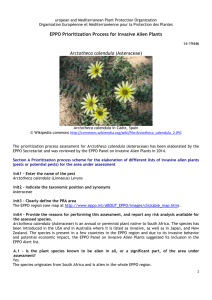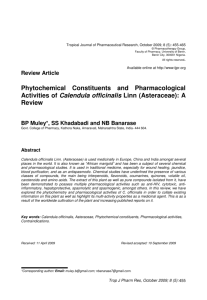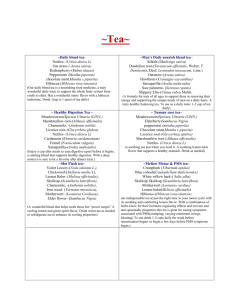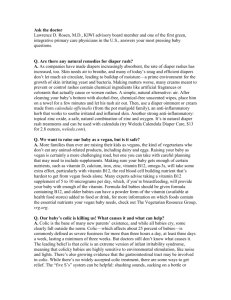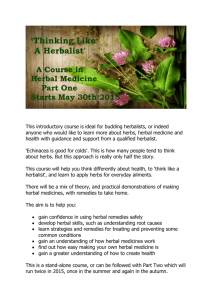Calendula
advertisement
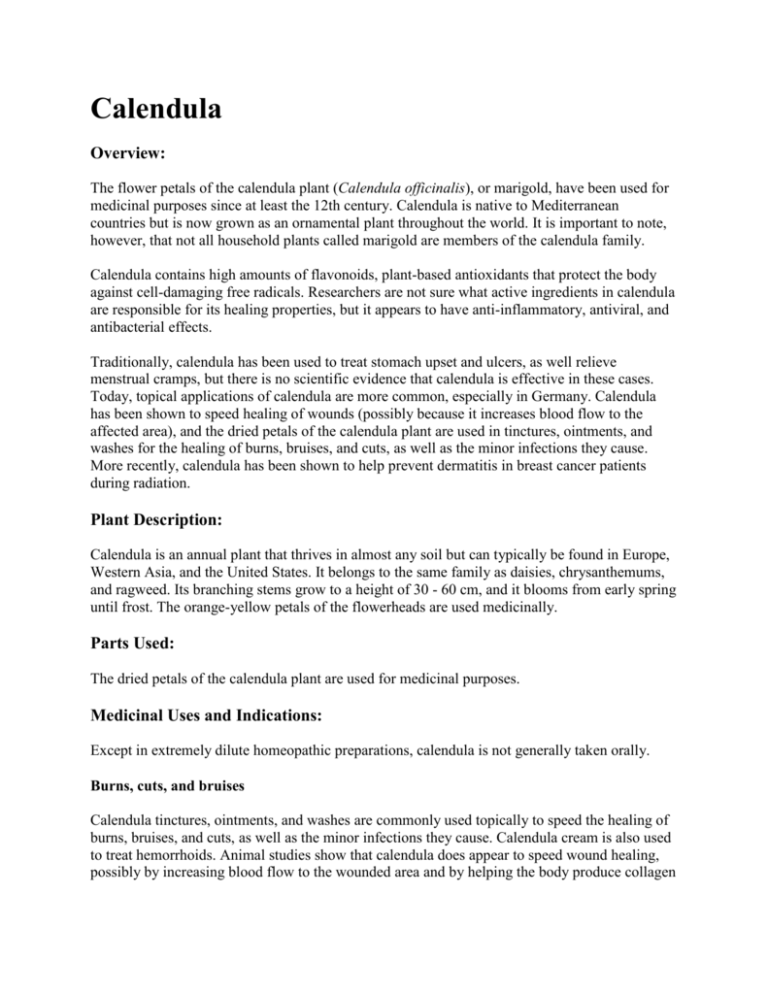
Calendula Overview: The flower petals of the calendula plant (Calendula officinalis), or marigold, have been used for medicinal purposes since at least the 12th century. Calendula is native to Mediterranean countries but is now grown as an ornamental plant throughout the world. It is important to note, however, that not all household plants called marigold are members of the calendula family. Calendula contains high amounts of flavonoids, plant-based antioxidants that protect the body against cell-damaging free radicals. Researchers are not sure what active ingredients in calendula are responsible for its healing properties, but it appears to have anti-inflammatory, antiviral, and antibacterial effects. Traditionally, calendula has been used to treat stomach upset and ulcers, as well relieve menstrual cramps, but there is no scientific evidence that calendula is effective in these cases. Today, topical applications of calendula are more common, especially in Germany. Calendula has been shown to speed healing of wounds (possibly because it increases blood flow to the affected area), and the dried petals of the calendula plant are used in tinctures, ointments, and washes for the healing of burns, bruises, and cuts, as well as the minor infections they cause. More recently, calendula has been shown to help prevent dermatitis in breast cancer patients during radiation. Plant Description: Calendula is an annual plant that thrives in almost any soil but can typically be found in Europe, Western Asia, and the United States. It belongs to the same family as daisies, chrysanthemums, and ragweed. Its branching stems grow to a height of 30 - 60 cm, and it blooms from early spring until frost. The orange-yellow petals of the flowerheads are used medicinally. Parts Used: The dried petals of the calendula plant are used for medicinal purposes. Medicinal Uses and Indications: Except in extremely dilute homeopathic preparations, calendula is not generally taken orally. Burns, cuts, and bruises Calendula tinctures, ointments, and washes are commonly used topically to speed the healing of burns, bruises, and cuts, as well as the minor infections they cause. Calendula cream is also used to treat hemorrhoids. Animal studies show that calendula does appear to speed wound healing, possibly by increasing blood flow to the wounded area and by helping the body produce collagen proteins, which are used to heal skin and connective tissue. Although no scientific studies in humans support these uses, applying calendula topically is considered safe. Professional homeopaths often recommend ointments containing calendula to heal first-degree burns and sunburns. Dermatitis Preliminary evidence suggests that calendula may help prevent dermatitis in breast cancer patients during radiation. In one study of 254 patients, women who used calendula lotion were less likely to grade II or higher dermatitis compared to those who used trolamine lotion. Ear infection (otitis media) Ear drops containing calendula are sometimes used to treat ear infections in children. A few scientific studies have shown no side effects, although the studies are not of sufficient quality to determine whether calendula is truly effective. Available Forms: Fresh or dried calendula petals are available in tinctures, liquid extracts, infusions, ointments, and creams. Calendula products should always be protected from light and moisture, and should not be used after 3 years of storage. How to Take It: Pediatric Use only topical and homeopathic preparations for children. Calendula can be used externally in creams and ointments in dosages of 2 - 5 g calendula per 100 g cream or ointment. For homeopathic dosages, consult a licensed homeopath. Adult Infusion: 1 tsp (5 - 10 g) dried florets in 8 oz (250 mL) water; steep 10 - 15 minutes; drink 2 - 3 cups per day Fluid extract (1:1 in 40% alcohol): 0.5 - 1.0 mL 3 times per day Tincture (1:5 in 90% alcohol): 5 - 10 drops (1 - 2 mL) 3 times per day Ointment: 2 - 5% calendula; apply 3 - 4 times per day as needed Precautions: The use of herbs is a time-honored approach to strengthening the body and treating disease. Herbs, however, can trigger side effects and can interact with other herbs, supplements, or medications. For these reasons, you should take herbs with care, under the supervision of a health care provider. Calendula is generally considered safe for topical application. It should not be applied to an open wound without a doctor's supervision. People who are sensitive to plants in the daisy or aster family, including chrysanthemums and ragweed, may also have an allergic reaction to calendula (usually a skin rash). Calendula is also known to affect the menstrual cycle and should not be used during pregnancy and breastfeeding. Theoretically, calendula may affect conception when taken by a man or woman, so couples trying to get pregnant should not use calendula. Possible Interactions: There are no known scientific reports of interactions between calendula and conventional or herbal medications. Theoretically, calendula may interact with sedative and antihypertensive (blood pressure) drugs, so talk to your doctor before combing these drugs with calendula. Alternative Names: Calendula officinalis; Garden marigold; Pot marigold Reviewed last on: 12/5/2008 Steven D. Ehrlich, NMD, private practice specializing in complementary and alternative medicine, Phoenix, AZ. Review provided by VeriMed Healthcare Network. Supporting Research Barajas-Farias LM et al. A dual and opposite effect of Calendula officinalis flower extract: chemoprotector and promoter in rat hepatocarcinogenesis model. PLanta Med. 2006;72(3):21721. Basch E, Bent S, Foppa I, et al. Marigold (Calendula officinalis):An evidence-based systematic review by the Natural Standard Research Collaboration. J Herb Pharmacother. 2006;6(3-4):13559. Blumenthal M, ed. The Complete German Commission E Monographs. Therapeutic Guide to Herbal Medicines. Boston: Integrative Medicine Communications; 1998: 100. Duran V, Matic M, Jovanovc M, et al. Results of the clinical examination of an ointment with marigold (Calendula officinalis) extract in the treatment of venous leg ulcers. Int J Tissue React. 2005;27(3):101-6. Gruenwald J, Brendler T, Christof J. PDR for Herbal Medicines. Montvale, NJ: Medical Economics Company; 1998: 704-706. Hematology/Oncology Clinics of North America. Dietary supplement use in cancer care: Help or harm. Hematology/Oncology Clinics of North America. 2008;22(4). Jimenez-Medina E, Garcia-Lora A, Paco L, Algarra I, Collado A, Garrido F. A new extract of the plant Calendula officinalis produces a dual in vitro effect: cytotoxic anti-tumor activity and lymphocyte activation. BMC Cancer. 2006;6:119. Kalvatchev Z, Walder R, Garzaro D. Anti-HIV activity of extracts from Calendula officinalis flowers. Biomed Pharmacotherapy. 1997;51(4):176-180. Sarrell EM, Cohen HA, Kahan E. Naturopathic treatment for ear pain in children. Pediatrics. 2003 May;111(5 Pt 1):e574-9. Sarrell EM, Mandelberg A, Cohen HA. Efficacy of naturopathic extracts in the management of ear pain associated with acute otitis media. Arch Pediatr Adolesc Med. 2001;155(7):796-799. Ullman D. The Consumer's Guide to Homeopathy. New York, NY: Penguin Putnam; 1995:254255;334.

